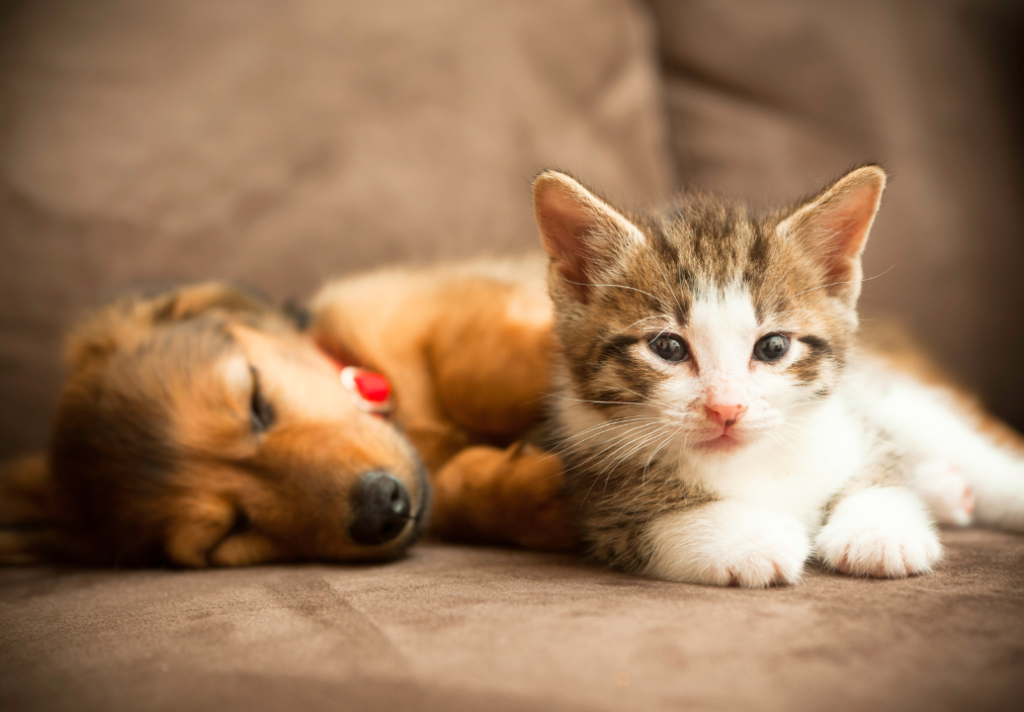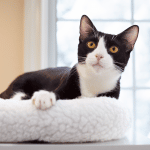Introducing a new pet to your cat can be an exciting yet challenging experience. How can you ensure a seamless transition and create harmony between your feline friend and their new companion? Let us share our best, actionable strategies and offer step-by-step guidance to help you introduce a new pet to your cat in a way that fosters acceptance and minimizes stress for all of you.

Assessing Your Cat’s Personality and Preferences
Understanding your cat’s personality and preferences is crucial when introducing a new pet into their life. Cats, like humans, have unique characteristics that shape their interactions and reactions. By assessing your cat’s behavior, you can make informed choices that will help minimize stress and create a harmonious environment for both your cat and the new pet.
Understanding Cat’s Personality
Your cat’s personality is made up of all their adorable traits, which can be influenced by various factors such as genetics, early experiences, and socialization. Some cats may have outgoing and adventurous personalities, while others may be more reserved and cautious. It is essential to observe your cat’s behavior in different situations to gain insights into their personality. Here are a few key characteristics to consider:
- Temperament: Is your cat generally calm or easily excitable?
- Socialization: How comfortable is your cat around new people or animals?
- Playfulness: Does your cat enjoy interactive play or prefer solitary activities?
- Tolerance: How well does your cat handle changes in their environment or routine?
- Communication: How does your cat express their needs and emotions?
Identifying Cat’s Preferences
Just like humans, cats also have preferences for certain activities, toys, and environments. Understanding your cat’s preferences will allow you to provide them with an enriching and stimulating environment. Here are a few aspects to consider:
- Toys: Does your cat enjoy chasing toys, batting at objects, or playing with puzzle toys?
- Scratching Preference: Does your cat prefer vertical or horizontal scratching surfaces?
- Resting Spaces: Does your cat prefer elevated perches, cozy beds, or secluded hideaways?
- Food and Treats: Is your cat particular about their food preferences or treat choices?
“By understanding your cat’s personality and preferences, you can create a welcoming environment for the new pet and ensure a smoother and stress-free introduction.”
Choosing the Right Pet for Your Cat
When adding a new pet to your household, it’s essential to consider your cat’s temperament and compatibility to ensure a harmonious relationship. By selecting a pet that matches your cat’s personality and preferences, you can greatly increase the chances of a more successful friendship.
Here are some factors to consider when choosing the right pet for your cat:
1. Size and Energy Level
Take into account your cat’s size and energy level when selecting a new pet. If your cat is laid-back and prefers a quieter environment, a calm small dog or a low-energy cat may be a better fit. On the other hand, if your cat is active and playful, a high-energy dog or a cat with a similar temperament can be an excellent companion.
2. Socialization Needs
Consider your cat’s socialization needs. Some cats are highly sociable and enjoy the company of other animals, while others may prefer to be the only pet in the household. If your cat has a history of getting along well with other animals, it may be more open to sharing its space with a new pet.
3. Prey Drive
If your cat has a strong hunting instinct, it’s essential to avoid adding small animals, such as birds or rodents, as they may trigger predatory behavior. Instead, opt for a pet that won’t be perceived as prey, such as a dog or another cat.
4. Breed and Breed Compatibility
Consider the breed of your cat and the potential new pet. Some breeds have specific temperaments and traits that may affect their compatibility. It’s important to research and understand the characteristics of both your cat’s breed and the breed of the new pet to ensure they are likely to get along.
5. Slow Introduction!
Regardless of the type of pet you choose, a slow introduction is crucial. Gradually introduce the new pet to your cat, allowing them to become familiar with each other’s scents and presence before direct interaction. This patient approach will help reduce stress and increase the chances of a positive relationship.
Preparing Your Home for the New Arrival
Before bringing your new pet home, it’s important to prepare your living space to ensure a safe and comfortable environment for both your existing pet and the newcomer. Taking these steps will help create a smooth transition and minimize any potential conflicts.
1. Create Separate Spaces
It’s crucial to establish separate spaces for your cat and the new arrival. This allows each pet to have their own territory and reduces the likelihood of any unpleasant territorial disputes. Dedicate a room or area for the new pet with all necessary supplies, such as a bed, litter box, food, and water bowls.
2. Remove Hazards
Scan your home for potential hazards before the new pet’s arrival. Secure loose cords, cover electrical outlets, and remove toxic plants or substances that could be harmful if ingested. This precautionary measure ensures a safe environment for both pets.
3. Provide Personalized Items
Ensure that each pet has their own set of items to prevent competition and create a sense of security. This includes separate food and water bowls, as well as separate litter boxes for cats. Providing individual resources helps minimize stress and maintains harmony between the pets.
4. Socialize Your Pets Gradually
If your cat is not accustomed to other animals, gradually introduce them to the presence and scent of the new pet. This can be done by swapping bedding or using a pheromone diffuser to alleviate stress. Slowly increasing exposure allows both pets to become familiar with each other’s presence before any direct interactions.
5. Consider Pet Gates and Barriers
Using pet gates or barriers can be helpful during the initial stages of introducing the new pet. This allows for supervised interactions while maintaining a physical barrier, ensuring the safety of both pets. Gradually reduce the use of barriers as the pets become more comfortable with each other.
By preparing your home and creating a safe and comfortable environment, you are setting the stage for a successful integration of your new pet. These steps will help ease the transition and promote a harmonious relationship between your existing pet and the newcomer.
Setting Up Separate Spaces
In order to ensure a smooth and gradual introduction between your new pet and your cat, it is important to set up separate spaces for them. Providing individual territories for each of them allows them to adjust to their new living arrangements at their own pace and reduces the likelihood of conflict. Here’s why setting up separate spaces is crucial for a successful introduction:
- Reduced Stress: Cats are territorial animals and tend to feel more secure when they have their own space. By giving your cat a designated area, such as a separate room or a specific part of the house, they can retreat to and feel safe while adjusting to the presence of the new pet.
- Establishing Boundaries: Setting separate spaces helps establish boundaries and prevents any potential territorial disputes between the new pet and your cat. It allows each animal to have their own area to eat, sleep, and play without feeling threatened by the other.
- Gradual Introduction: By providing separate spaces, you can gradually introduce the new pet and your cat in a controlled manner. This allows them to become familiar with each other’s scents and presence without direct physical interactions, which can be overwhelming initially.
Creating separate spaces for your new pet and your cat is an important step in ensuring a smooth and harmonious integration. It helps alleviate stress, establishes boundaries, and allows for a gradual introduction between the two animals. Let’s move on to the next section where we will explore the scent exchange technique as a way to familiarize your cat with the new pet’s scent before their physical introduction.
Scent Exchange Technique
Introducing a new pet to your cat can sometimes be a delicate process, as cats are known for being territorial creatures. However, with the scent exchange technique, you can help create a smoother and more accepting transition for your cat.
The scent exchange technique involves familiarizing your cat with the scent of the new pet before their physical introduction. This allows your cat to gradually get accustomed to the presence of the new pet and reduces the potential for conflict.
To implement the scent exchange technique, follow these steps:
- Begin by gently rubbing a soft cloth or towel on the new pet, focusing on areas that have their unique scent, such as their head, neck, and back.
- Take the cloth or towel and place it near your cat’s feeding or resting area. This allows your cat to become familiar with the scent in a comfortable and non-threatening environment.
- Repeat this process daily, ensuring that you use a fresh cloth or towel each time to maintain the new pet’s scent.
- Observe your cat’s behavior during this process. If your cat shows signs of curiosity or approaches the scented cloth without aggression, it is a positive indication of acceptance.
The scent exchange technique is effective because cats rely heavily on their sense of smell to navigate their surroundings. By exposing your cat to the new pet’s scent in a neutral territory, you are essentially bridging the gap between the unfamiliar and the familiar.
Gradually, your cat will begin associating the new pet’s scent with positive experiences, paving the way for a more harmonious introduction when the time comes for them to meet face-to-face.
Visual Introduction with Physical Barrier
When introducing your cat to a new pet, a visual introduction with a physical barrier can be an effective strategy. This method allows both animals to see and observe each other while maintaining a safe distance, gradually building familiarity.
Visual introduction:
Creating a visual introduction involves positioning your cat and the new pet in separate spaces within your home where they can see each other, but not have direct physical contact. This can be done by using baby gates, pet playpens, or even glass doors.
Physical barrier:
The physical barrier acts as a form of protection, preventing any potential aggressive behaviors or conflicts during the initial stages of introduction. It also allows both animals to gauge each other’s reactions and get comfortable with their presence.
This visual introduction with a physical barrier serves as a crucial step in the introduction process. It allows both animals to become accustomed to each other’s presence, scents, and body language, paving the way for a smoother transition and minimizing the likelihood of any negative reactions.
Controlled Interactions and Positive Reinforcement
In order to ensure a smooth and successful introduction between your cat and the new pet, it is crucial to implement controlled interactions and utilize positive reinforcement techniques. These strategies will help create a positive and harmonious environment for both animals, promoting a healthy and lasting relationship. Consider:
- Start with short, supervised meetups
- Use positive reinforcement for desirable behaviors
- Gradually remove physical barriers
Supervised Face-to-Face Meetings
Supervised face-to-face meetings play a crucial role in introducing your cat and the new pet. These meetings provide an opportunity for them to interact, communicate, and establish a bond under your watchful eye. By following proper guidelines, you can ensure the safety and well-being of both animals throughout this process.
Creating a Safe Environment
Before initiating the face-to-face introduction, ensure that the environment is secure and free from any potential hazards. Remove any items that may cause stress, such as loud noises or unfamiliar objects. Additionally, make sure both the cat and the new pet have access to their respective safe spaces if they need to retreat and feel secure.
Supervision and Control
During the face-to-face meetings, it’s essential to supervise the interactions closely to prevent any aggressive behaviors or harm. Keep a close eye on their body language and intervene if necessary. If tension arises, gently separate them and give them some time apart before trying again.
Positive Reinforcement
Throughout the supervised meetings, be sure to reward positive behaviors from both the cat and the new pet. This can include giving treats, praise, or a favorite toy. Positive reinforcement helps create positive associations and encourages them to build a friendly relationship.
Gradual Increase in Interaction Time
When introducing a new pet to your cat, it is crucial to allow for a gradual increase in the duration of their interaction over time. This measured approach ensures a smooth transition and minimizes any potential conflicts between your cat and the new pet.
Observe your cat’s body language and behavior during these interactions. If your cat shows signs of stress or aggression, it’s important to take a step back and give them more time to adjust.
Patience and consistency are key in this process. By gradually increasing the duration of their interaction time, you give your cat and the new pet the opportunity to develop a bond at their own pace.
Remember, every cat is unique, and the introduction process may vary. It’s crucial to monitor their interactions closely and provide support and guidance as needed. With patience, understanding, and love, you can successfully welcome a new companion into your cat’s life, creating a harmonious and happy home for everyone involved!






